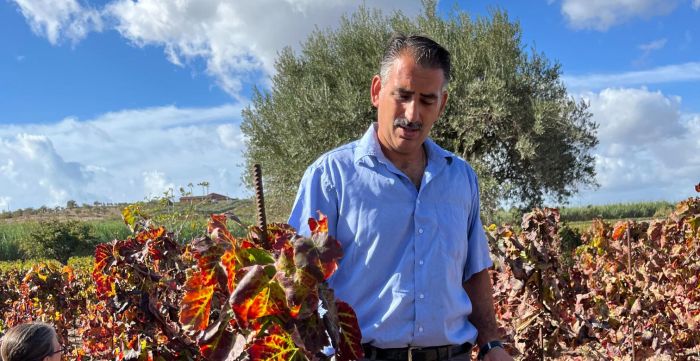producer profile
28.11.2023
Salvatore Marino Producer Profile
Salvatore Marino Producer Profile
Read more…
producer profile
<p>Wine has been made in Salvatore Marino’s family for generations; growing up, his grandfather and father produced bulk wine in a large facility within the town of <span class="zalup"><span><glossary term="Pachino" title="1480">Pachino</glossary><span>.</span></span></span> Always a bon vivant, Marino’s love for good food begat a passion for seeking delicious bottles from <glossary term="Sicily" title="951">Sicily</glossary> and beyond. It also made him dream of starting a project of his own. No stranger to <span class="zalup"><span><glossary term="Viticulture" title="1103">viticulture</glossary><span>,</span></span></span> Salvatore knew he could start farming vines from his wife Stefania’s family. But before branching out on his own, he felt the need to learn how to properly run a cellar.</p>
<p>Marino had learned how to make wine with his father, but found those bulk products riddled with defects, namely <span class="zalup"><span><glossary term="Brettanomyces" title="195">brett</glossary><span>.</span></span></span> So for many years, Salvatore cut his teeth working at huge wineries in California, <glossary term="Puglia" title="836">Puglia</glossary> and <glossary term="Sicily" title="951">Sicily</glossary> to further his knowledge of <span class="zalup"><span><glossary term="Enology" title="422">enology</glossary><span>.</span></span></span> </p>
<p><em>“I never liked the wines I made at those places. But you can can learn so much, so fast in those environments. The large scale gives you perspective.”</em></p>
<p>With a decade of big winery experience behind him, Salvatore launched his eponymous <glossary term="Estate" title="427">estate</glossary> in 2017. Today he works 15 <glossary term="Hectare" title="523">hectares</glossary> of land divided into five sectors, all close to each other and the town of <span class="zalup"><span><glossary term="Pachino" title="1480">Pachino</glossary><span>.</span></span></span> A firm believer in <span class="zalup"><span><glossary term="Polyculture" title="815">polyculture</glossary><span>,</span></span></span> seven of the 15 <glossary term="Hectare" title="523">hectares</glossary> are planted in vines, with the rest planted in fruit trees, wheat, other cereals, table grapes and much more. Some of the land is from Stefania’s family, some is rented and some Marino has purchased. The soils consist of medium to heavy <glossary term="Clay" title="301">clay</glossary> with <span class="zalup"><span><glossary term="Limestone" title="596">limestone</glossary><span>,</span></span></span> planted in <glossary term="Gobelet" title="497">bush-trained</glossary> vines wrapped up on pickets to avoid damage from the region’s constant winds. Salvatore and Stefania do everything themselves, save for some seasonal help around <glossary term="Pruning" title="834">pruning</glossary> and <glossary term="Harvest" title="521">harvest</glossary> seasons. </p>
<p>Though he still has access to the family winery, Salvatore does not feel comfortable making his wines there because he finds it too big and would rather be closer to the vines. In 2021, he purchased a four <glossary term="Hectare" title="523">hectare</glossary> property in the countryside where he is in the early stages of building a new winery, including a <span class="zalup"><span><glossary term="Cellar" title="254">cellar</glossary><span>,</span></span></span> stocking room, tasting room and guest rooms. The <glossary term="Cantina" title="233">cantina</glossary> is surrounded by <glossary term="Limestone" title="596">limestone</glossary> rich <span class="zalup"><span><glossary term="Coteau" title="345">coteaux</glossary><span>:</span></span></span> Salvatore has planted grafts of <glossary term="Nero d'Avola" title="714">Nero d’Avola</glossary> and <glossary term="Pignatello" title="797">Pignatello</glossary> and plans to plant <glossary term="Grecanico" title="1322">Grecanico</glossary> in the near future. </p>
<p>Three wines are currently produced. The bianco is 100% <span class="zalup"><span><glossary term="Catarratto" title="249">Catarratto</glossary><span>,</span></span></span> and comes from a 0.5 <glossary term="Hectare" title="523">hectare</glossary> vineyard planted by Salvatore in 2016 along with a 10 year old <glossary term="Parcel" title="760">parcel</glossary> of rented vines. It <glossary term="Maceration" title="610">macerates</glossary> five days before <glossary term="Fermentation" title="441">fermenting</glossary> in <span class="zalup"><span><glossary term="Stainless Steel" title="986">stainless steel</glossary><span>,</span></span></span> then <glossary term="Aging" title="74">ages</glossary> in <glossary term="Concrete" title="325">concrete</glossary> <glossary term="Vat/Tank" title="1140">tanks</glossary> before <span class="zalup"><span><glossary term="Bottling" title="185">bottling</glossary><span>.</span></span></span> <glossary term="Catarratto" title="249">Catarratto</glossary> is actually a bit of a rarity in <span class="zalup"><span><glossary term="Pachino" title="1480">Pachino</glossary><span>,</span></span></span> as <glossary term="Grillo" title="511">Grillo</glossary> has gained traction throughout <glossary term="Sicily" title="951">Sicily</glossary>; most of Marino’s contemporaries are exclusively replanting <glossary term="Marsala" title="633">Marsala</glossary>’s native white grape. In fact, only four producers currently cultivate <glossary term="Catarratto" title="249">Catarratto</glossary> and Salvatore is the only one focusing on new plantations.</p>
<p><em>“I like </em><glossary term="Grillo" title="511"><em>Grillo</em></glossary><em>, but I do not feel it is optimal for the </em><glossary term="Terroir" title="1026"><em>terroirs</em></glossary><em> of </em><glossary term="Pachino" title="1480"><em>Pachino</em></glossary><em>. My grandfather told me when I was young that </em><glossary term="Catarratto" title="249"><em>Catarratto</em></glossary><em> was the white grape for this area. I always remembered that.”</em></p>
<p>The <glossary term="Rosé/Rosato" title="871">rosato</glossary> is 100% <glossary term="Syrah" title="1001">Syrah</glossary> and a <span class="zalup"><span><glossary term="Direct Press" title="392">direct press</glossary><span>,</span></span></span> <glossary term="Fermentation" title="441">fermented</glossary> and <glossary term="Aging" title="74">aged</glossary> in <span class="zalup"><span><glossary term="Stainless Steel" title="986">stainless steel</glossary><span>.</span></span></span></p>
<p>Finally, the rosso is 95% <span class="zalup"><span><glossary term="Nero d'Avola" title="714">Nero d’Avola</glossary><span>,</span></span></span> 5% <span class="zalup"><span><glossary term="Pignatello" title="797">Pignatello</glossary><span>.</span></span></span> It <glossary term="Maceration" title="610">macerates</glossary> only six days, <glossary term="Fermentation" title="441">ferments</glossary> in <glossary term="Stainless Steel" title="986">stainless steel</glossary> then <glossary term="Aging" title="74">ages</glossary> in <span class="zalup"><span><glossary term="Concrete" title="325">concrete</glossary><span>.</span></span></span> Salvatore’s ultimate goal with this wine is to be versatile with a meal (we can confirm it’s very good with fish) but also something you’d want to keep drinking after you’re done eating or even on its own.</p>





